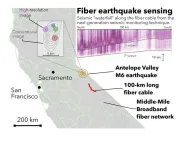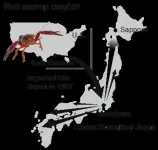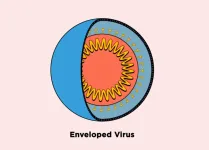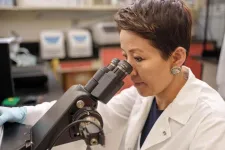(Press-News.org)
In California, thousands of miles of fiber optic cables crisscross the state, providing people with internet. But these underground cables can also have a surprising secondary function: they can sense and measure earthquakes. In a new study at Caltech, scientists report using a section of fiber optic cable to measure intricate details of a magnitude 6 earthquake, pinpointing the time and location of four individual asperities, the "stuck" areas of the fault, that led to the rupture.
For several years, Professor of Geophysics Zhongwen Zhan (PhD '14) and his team have aimed to show that repurposing fiber optic cables is a simple way to drastically expand our ability to measure seismic activity by producing a dense network of makeshift seismometers in a method called distributed acoustic sensing. The new study, appearing in the journal Nature, utilized only a 100-kilometer section of cable to precisely understand the complex mechanics behind a particular 2021 earthquake, suggesting that access to more cables would enable improved understanding of earthquake physics and ultimately better earthquake early-warning systems.
"If we can get broader coverage to measure seismic activity, we can revolutionize how we study earthquakes and provide more advance warning," says Zhan. "Though we cannot predict earthquakes, distributed acoustic sensing will lead to a better understanding of the details underlying how the earth ruptures."
There are about 500 seismometers throughout the roughly 56,500 square miles in Southern California, and each one costs up to $50,000. On the other hand, utilizing fiber optic cables throughout the state could be equivalent to blanketing it with millions of seismometers.
To use a fiber optic cable as a seismometer, laser emitters are stationed at one end of the cable, shooting beams of light through the long, thin glass strands that make up the cable's core. The glass has tiny imperfections that reflect back a minuscule portion of the light to the source, where it is recorded. In this manner, each imperfection acts as a trackable waypoint along the fiber optic cable, which is typically buried just below ground level. Seismic waves moving through the ground cause the cable to wiggle slightly, which changes the travel time of light to and from these waypoints. Thus, the imperfections along the cable's length act like thousands of individual seismometers that allow seismologists to observe the motion of seismic waves.
In this new study, the team examined the light signatures traveling through a stretch of fiber optic cable located in the Eastern Sierra Nevada during the 2021 Antelope Valley magnitude 6 earthquake. The section of cable was equivalent to 10,000 seismometers and was able to discover that the M6 was made up of a sequence of four smaller ruptures. These so-called "sub-events," like mini earthquakes, could not be detected by a conventional seismic network.
In collaboration with the laboratory of Nadia Lapusta, the Lawrence A. Hanson, Jr., Professor of Mechanical Engineering and Geophysics, the team was able to create an accurate model of the M6 earthquake based on the measured seismic activity. The model showed the timing of the four sub-events and pinpointed their exact locations on the fault region.
"Using fiber optic cable as a series of seismometers reveals aspects of earthquake physics that have long been hypothesized but difficult to image," says Zhan. "As an analogy, imagine your everyday backyard telescope. You can see Jupiter, but you probably can't see its moons or any details. With a really powerful telescope, you can see the fine details of the planet and moon surfaces. Our technology is like a powerful telescope for earthquakes."
The paper is titled "The break of earthquake asperities imaged by distributed acoustic sensing." Jiaxuan Li, postdoctoral scholar research associate in geophysics, is the study's first author. In addition to Zhan, Li, and Lapusta, additional co-authors are graduate student Taeho Kim and DAS scientist Ettore Biondi. Funding was provided by the National Science Foundation.
END
A non-opioid designer molecule for treating chronic neuropathic pain by calming hyperactive pain-sensing neurons in the peripheral nervous system has had promising results in a preclinical study conducted by researchers at Weill Cornell Medicine and the Burke Neurological Institute.
In the study, published Aug. 2 in the British Journal of Anaesthesia, the first-in-class drug conceptualized by lead author Dr. Gareth Tibbs was found to function according to its design at both the molecular level and as an apparently side-effect-free pain reliever in rats.
“With either a single dose or seven days of daily dosing, we saw a significant reversal of neuropathic pain signs in the ...
“We searched for human genetic variation that associates with spontaneous control of HIV and identified a novel region in the genome that is only variable in populations of African ancestries,” says Professor Jacques Fellay at EPFL’s School of Life Sciences. “We used a combination of computational and experimental approaches to explore the biological mechanism behind the genetic association and provide evidence that the gene CHD1L acts to limit HIV replication in a subset of white blood cells.”
HIV is still a problem
Despite significant advances in treatment and access to therapy, the ...
Owing to human activities and climate change, many animal species have invaded new habitats. Such biological invasion comes with devastating impacts on the local biodiversity and ecosystems. The red swamp crayfish—known to the scientific world as Procambarus clarkii (P. clarkii)— is no exception. P. clarkii is a freshwater crayfish native to the tropical regions of southern USA and northeastern Mexico. After their introduction to different parts of the world, they have become one of the most widespread and invasive animal species. They are known for their adaptability and aggressive behavior that ensure their survival in a wide range of environments, ...
Breast cancer survival rates have improved considerably in the last few decades in Colombia, but factors that increase the likelihood of patients experiencing cardiovascular side effects, like cardiotoxicity, are not well-known or well-treated. A recent study in the North-East region of Colombia found 11.94% of patients with a high BMI being treated for breast cancer at a regional center experienced heart damage, or cardiotoxicity, during chemotherapy. The study will be presented at the American College of Cardiology (ACC) Latin America 2023 Together with Asociación Costarricense ...
AUSTIN, Texas – A new statistical tool can help researchers get meaningful results when a randomized experiment, considered the gold standard, is not possible.
Randomized experiments split participants into groups by chance, with one undergoing an intervention and the other not. But in real-world situations, they can’t always be done. Companies might not want to use the method, or such experiments might be against the law.
Developed by a researcher at The University of Texas at Austin, the new tool called two-step synthetic control adapts an existing research workaround, known as the synthetic control method.
The ...
The first-ever study to look at drivers of both marine heatwaves and cold spells in the shallow nearshore along the California Current —coordinated by California Polytechnic State University, San Luis Obispo (Cal Poly) and the Virginia Institute of Marine Science, William & Mary — found that certain environmental conditions and the state of the ocean can lead to an enhanced risk for ocean temperature extremes.
The findings were recently published in Nature Scientific Reports in an article titled “Effects of basin-scale climate modes and upwelling on nearshore marine heatwaves and cold spells in the California Current.”
Extreme ...
Just as bacteria can develop antibiotic resistance, viruses can also evade drug treatments. Developing therapies against these microbes is difficult because viruses often mutate or hide themselves within cells. But by mimicking the way the immune system naturally deals with invaders, researchers reporting in ACS Infectious Diseases have developed a “peptoid” antiviral therapy that effectively inactivates three viruses in lab tests. The approach disrupts the microbes by targeting certain ...
Antiviral therapies are notoriously difficult to develop, as viruses can quickly mutate to become resistant to drugs. But what if a new generation of antivirals ignores the fast-mutating proteins on the surface of viruses and instead disrupts their protective layers?
“We found an Achilles heel of many viruses: their bubble-like membranes. Exploiting this vulnerability and disrupting the membrane is a promising mechanism of action for developing new antivirals,” said Kent Kirshenbaum, professor of chemistry at NYU and the study’s senior author.
In a new study ...
DALLAS, August 2, 2023 — The American Heart Association, a relentless force for a world of longer, healthier lives, has recognized 2,671 health care and emergency response organizations — nearly 145 more than in 2022 — for their commitment to improving health outcomes for cardiovascular patients through evidence-based efficient and coordinated care.
The American Heart Association’s Get With The Guidelines® and Mission: Lifeline® are hospital-based quality improvement recognition programs that use the latest evidence-based scientific guidelines to save lives and hasten health care recovery ...
With a survival rate in the single digits, pancreatic ductal adenocarcinoma (PDAC) is highly lethal. In fact, by the time PDAC is clinically diagnosed, it is already considered incurable via surgery or other means in up to 90% of patients.
Yangzom D. Bhutia, D.V.M., Ph.D., from the Department of Cell Biology and Biochemistry at the Texas Tech University Health Sciences Center (TTUHSC) School of Medicine, has for years focused her research on PDAC. To bolster her efforts, the National Cancer Institute at the National Institutes of Health recently awarded Bhutia a five-year, $1.76 million grant (“SLC6A14 as a unique ...





